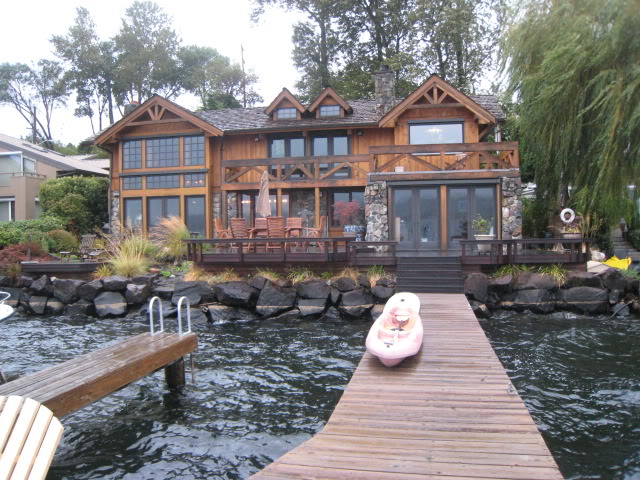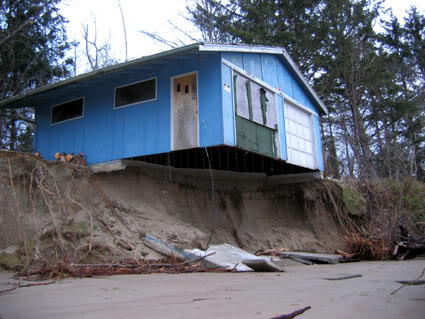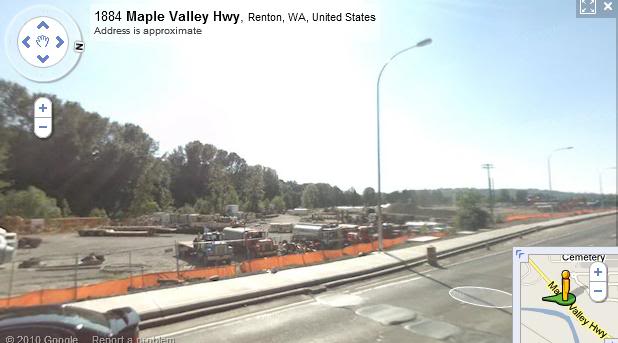 The rock bulkhead on the shoreline of this Renton home provides crucial protection from wave-induced erosion caused by large boats and winter storms. I agree with property owners that existing bulkheads should be entitle to be used throughout their useful service lives even when upland changes are being made.
The rock bulkhead on the shoreline of this Renton home provides crucial protection from wave-induced erosion caused by large boats and winter storms. I agree with property owners that existing bulkheads should be entitle to be used throughout their useful service lives even when upland changes are being made.
After months of hard work by Renton city staff and Renton’s shoreline property owners, the new Renton Shoreline Management Program is getting close to being ready for council approval. (Click here to see my previous articles on this topic). However, I have a remaining concern which relates to the proposed regulation of existing bulkheads. I’ll explain the issue in three parts:
First, my sincere appreciation:
I am grateful to all the affected parties for the collaborative work they have performed to get us to this point. Everyone–city staff, planning commissioners, state officials, shoreline owners, and elected officials–all have demonstrated a strong desire to maintain a healthy shoreline with good wildlife protection. Merging this shared desire with other legitimate interests in recreation, economic development, flood management, and private property rights has taken time and patience. Mayor Law and his senior staff have played an important role in providing the time and opportunity for these issues to get worked out.
Second, some background on riverfront zoning, and on existing bulkheads in general.
For at least two decades, many citizens have requested new ways to enjoy the the Cedar River through water-front dining, water-front cafes, and waterfront event space (for weddings, etc). Under Mayor Jesse Tanner, we rezoned property on the north bank of the Cedar River east of I-405 to accomodate such a vision. (Technically referred to as COR zoning, this allows a broad range of water-front and other types of high-end uses.) The Stoneway Concrete company even moved its concrete batch plant out of this zone to clear the way for this type of multi-use development. We hoped then and still intend to see a river-front “Carillon Point”-type development encompassing the old Stoneway site, the Rivierra Apartments site, and the site of other existing uses which all seem to “turn their back” on the River. The envisioned redevelopment could also include hotels, high-end office space, and condominiums, uses that would work synergistically with Cedar River Park and the Cedar River Trail. Office workers, hotel guests and residents could enjoy lunchtime walks in the park and on the trail, while trail and park users could stop into the new cafes for lunch, snacks, beverages, or simply to get out of a rainstorm. Everyone involved understands that such a development would be subject to a 50-foot building setback from the river. But fifty feet is close enough for the buildings to capture the river’s beauty and sounds, and visitors could dine outside closer to the river’s edge. The SMP should provide enough flexibility so that diners can see the water. Citizens of Renton could enjoy riverfront that is currently inaccessible to the public.

The owners of the Stoneway site and Riviera Apartments are positioned to create hotel, office and waterfront dining space, similar to the Carillon Point Beach Cafe shown above.
The old Stoneway industrial site and the Riviera Apartments site are nicely situated above winter flood waters, and the Stoneway shoreline is protected by a long-standing bulkhead that has proven reliable. Similarly, most developed properties on Lake Washington have bulkheads of some type protecting their homes from the scouring effects of high waves during winter storms. Very few Renton lakeside properties have sufficient land to accommodate a gently-sloping beach. Most have an embankment, protected from sloughing by concrete or rock bulkheads. These bulkheads require substantial design and permitting efforts in addition to the costs of construction, and can cost more than one hundred thousand dollars on many home sites. Renton has installed many flood control measures and lakeside bulkheads on public property, such as the flood walls along the airport, and bulkheads near our restaurants in Coulon Park. And it’s not just Renton–last year our region created a new taxing district to pay for new levees and flood protections on the Green River, while the City of Seattle has been undergoing contortions trying to find funding for a new sea wall to protect its Puget Sound waterfront.
As a city official and a taxpayer, I’m appreciative of those riverfront and lakefront property owners who have used their private funds and negotiated the labyrinth of permitting agencies, hired the contractors, and installed storm protection for their property. When urban shorelines have inadequate flood and storm protection, we all end up paying for it one way or another. Left to nature, rivers will meander and scour– it’s what they do. They remove sediment on the high-velocity outside edge of river bends, undercut natural embankments, and carve wider and wider valleys. It’s a beautiful thing in an alpine meadow or at the Grand Canyon, but it is generally disastrous within an urban area like Renton.

Washaway Beach, on the Washington coast, provides a dramatic demonstration of the destructive power of shoreline erosion.
Finally, here is my concern.
The problem with the current draft of Renton’s SMP is that, if adopted, it would require property owners to evaluate removal or reduction of their existing protective bulkheads if the owner adds 1000 square feet or more of new construction to his/her property, or proposes a change in use of the property, even if the owner plans no change to the bulkhead. Under the draft SMP’s current language, the property owner would be required to hire a geotechnical engineer who would opine whether the bulkhead is necessary to protect the property from imminent damage during only THE THREE YEARS following the engineer’s review, an unreasonably short time in view of the uncertainty regarding when the next big storm will hit. If, in the opinion of the engineer, the property would not be imperiled in the next three years without the bulkhead, then the bulkhead would have to come out or be modified at great expense to a different design–or else the homeowner would not be allowed to do the 1000 square-foot addition.
To make matters worse, even if the engineer concluded that the existing bulkhead was needed, there could be a series of time-consuming and expensive reviews and appeals of this decision by government agencies or other persons.
While it is laudable to want to restore the lake and river shorelines to the most natural state possible, the primary effect that this proposed policy governing existing bulkheads will have is to keep residential and business properties from being remodeled or redeveloped. Property owners will be very reluctant to take on a building expansion or replacement project if they are faced with the risk of having to modify their existing bulkheads, structures that often may have 50 or 100 years of useful service life left in them.
Furthermore, this proposed new requirement is throwing doubt and confusion at the owners of property along the Cedar River where the city has done massive legwork–and even negotiated removal of a concrete plant–to prepare for future cafes, restaurants, and hotels (“Carillon Point on the River”). The current SMP language raises the specter that the existing bulkheads on the Cedar River shoreline might be required to come out as a condition of site redevelopment. Anxiety stemming from that specter is likely to dampen redevelopment prospects for the old Stoneway site.
I think a much better approach would be for the SMP to read that when a bulkhead is ultimately replaced–which will happen when it’s reached the end of its serviceable life (such as when the concrete crumbles, the steel rusts through, the wood rots away, or the entire bulkhead is undercut by the river or lake)–AT THAT TIME the need for the bulkhead should be reviewed by an appropriate engineer and local and state agencies. That would be the point in time at which all interests logically converge. That is the time that the shoreline must be disturbed to remove or replace the bulkhead. And that is the time that the property owner is forced by nature (not the city) to pay for studies and reconstruction.
The text of the state SMP guidelines supports the view that the right time to review the need for existing bulkheads is when the bulkheads are being replaced. So I believe the Department of Ecology and other stakeholders would accept this change.
With such a change I feel we would be about ready to approve the SMP.

For reference, the river-front Stoneway Industrial site in it’s current condition.

Recent Comments